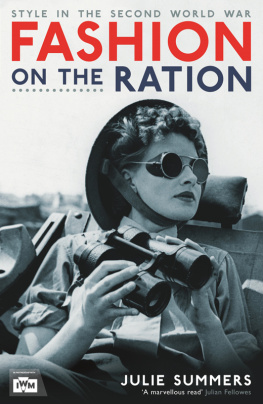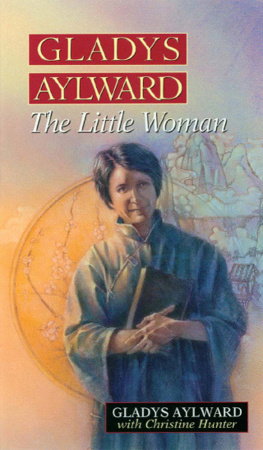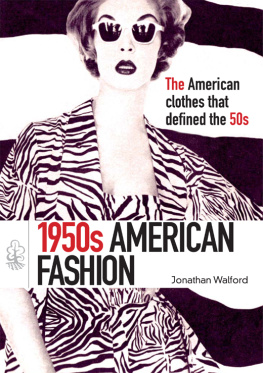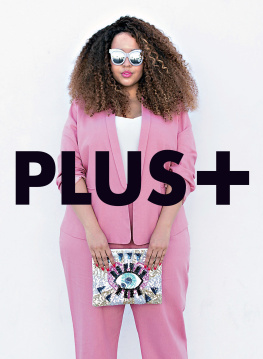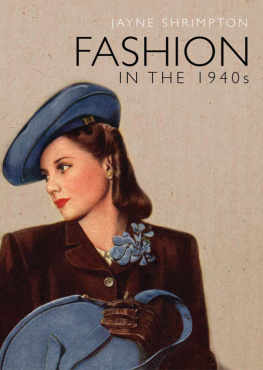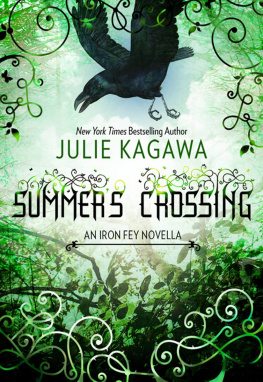STYLE IN THE SECOND WORLD WAR
FASHION
ON THE RATION
JULIE SUMMERS
In Partnership with Imperial War Museums

First published in Great Britain in 2015 by
PROFILE BOOKS LTD
3 Holford Yard
Bevin Way
London wc1x 9hd
www.profilebooks.com
In partnership with IWM
iwm.org.uk
Copyright Julie Summers, 2015
The moral right of the author has been asserted.
All rights reserved. Without limiting the rights under copyright reserved above, no part of this publication may be reproduced, stored or introduced into a retrieval system, or transmitted, in any form or by any means (electronic, mechanical, photocopying, recording or otherwise), without the prior written permission of both the copyright owner and the publisher of this book.
A CIP catalogue record for this book is available from the British Library.
eISBN 978 1 78283 097 9

for George B.
Introduction
Keep up the morale of the Home Front by preserving a neat appearance.
The Board of Trade, 1940
W hen the Second World War broke out in September 1939, it was to be total war, a war in which there were no non-combatants. Civilians and the military would both have to face the enemy, as the government had warned the public as early as 1932. Stanley Baldwin told the House of Commons: I think it is well also for the man in the street to realise that there is no power on earth that can protect him from being bombed The bomber will always get through.
The Second World War wrought almost incalculable destruction and horror, but it also produced astonishing bravery, great leadership and determination, as well as creativity and inventiveness. And as this was total war, these characteristics were mirrored on the home front as well as on the battlefield. The war accelerated the process, begun in 1914, of moving women out of the wings and into an active role, if not usually into active combat. Only the very young, the sick and the very elderly were passive participants in this war.
At the beginning, the government hoped that it could get away with the minimum amount of social and economic dislocation. The evacuation programme put paid to the first and the hole in the nations budget, which only got worse during the early months of the war, put paid to the latter. By the time France fell in June 1940, it was clear to everyone that the country was in for a long war and the government, which had by then already gained considerable control, took ever more steps to manage every minute aspect of peoples lives. As the novelist Barbara Cartland grumbled, in 1944 everything was rationed except, possibly, love.
If you ask anyone who lived through the war about clothes rationing, they will almost certainly tell you about coupons, parachute silk, utility clothing, Make-Do and Mend and perhaps Mrs Sew and Sew. Words such as drab, grey and threadbare are often applied to wartime clothing. Certainly, evacuee children who returned from abroad after the war were shocked by the absence of colour after the bright shades they had been used to in Canada, Australia and the United States. How we see clothing in wartime Britain is shaped by our knowledge in hindsight of the whole war and the years of austerity that followed it. Some people believed that the fashion industry stagnated during the war; others claim that it carried on creatively. The truth is somewhere in between. Far from being a story of drabness and misery, it is a story of colour, inventiveness and determination to carry on regardless of the shortages and constraints of the coupon culture.
The aim of this book is to take an overview of clothing and fashion during the Second World War in Britain. There was a marked difference then, as there is now, between haute couture and what the man or woman on the street wore. Early in the war, this gap narrowed and the style of everyday clothing changed and simplified, reflecting the desire to avoid wanton extravagance and frippery while men were away in the forces, fighting for the countrys freedom. I will look, too, at the consequences of having over 15 million Britons wearing uniform of one kind or another, and tease out the rationale and bureaucracy behind clothes rationing. Many myths have grown up around wartime clothing, from parachute silk underwear to Make-Do and Mend, obscuring some fascinating details of the real story, and I will examine these too.

One of a number of posters injecting a sense of urgency into the Make-Do and Mend campaign.
While womens fashion changed twice a year, mens suits and clothing tended to be mass produced and so did not go out of fashion so quickly. Thus it is the focus on the changing face of womens fashion that this book will concentrate on, though the austerity measures brought into play in 1942 had a major impact on the length of mens socks and the abolition of turn-ups on mens trousers, which caused uproar. Not everyone in Britain sought to wear the latest fashion all the time: for some it was a matter of choice or practicality; while for others it was simply that fashionable clothes were beyond their budget. Some had well-stocked wardrobes, others had plenty of dressmaking material, while many struggled on a meagre supply of pre-war clothing and what they could get with coupons. All these factors are relevant in illustrating how ordinary people dressed on and off coupon during the Second World War in Britain and how the fashion industry changed to reflect the different moods in the country over the course of the war.
During the early years of the war, the fashion houses continued to produce spring and autumn shows, and sometimes even a mid-season range would appear. In February 1940, the Paris couturiers presented their spring collections, which the London fashion editors quickly absorbed and recycled with comment for their readership. The emphasis was on coloured accessories such as scarves and hats, as well as nails and lipstick, to complement the grey-green, pinks and delicate blues of the early year. Tweeds were much in vogue and the cut of the two-piece costume for women and the suit for men owed much to the military uniform which was by then seen everywhere. Vogue featured Rhavis tweed coat tailored on guardsman lines, with spanking gold buttons. They make it in coral, too (more practical as a housecoat). Price 20 gns(approximately 1,100 in 2014). Paris still produced fashion into the summer of 1940 but their ability to export ended after the occupation of France.

